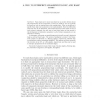2022 search results - page 378 / 405 » Natural-Language Semantics for Associations |
SLOGICA
2008
13 years 10 months ago
2008
Fuzzy logics are in most cases based on an ad-hoc decision about the interpretation of the conjunction. If they are useful or not can typically be found out only by testing them wi...
SP
2008
IEEE
13 years 10 months ago
2008
IEEE
This paper presents FABLE, a core formalism for a programming language in which programmers may specify security policies and reason that these policies are properly enforced. In ...
TOPLAS
2008
13 years 10 months ago
2008
WS-SecurityPolicy is a declarative language for configuring web services security mechanisms. We describe a formal semantics for WS-SecurityPolicy and propose a more abstract lang...
URBAN
2008
13 years 10 months ago
2008
Intuitive and meaningful interpretation of geographical phenomena requires their representation at multiple levels of detail. This is due to the scale dependent nature of their pr...
ENTCS
2002
13 years 9 months ago
2002
Dynamic Logic Programming (DLP) was introduced to deal with knowledge about changing worlds, by assigning semantics to sequences of generalized logic programs, each of which repres...

